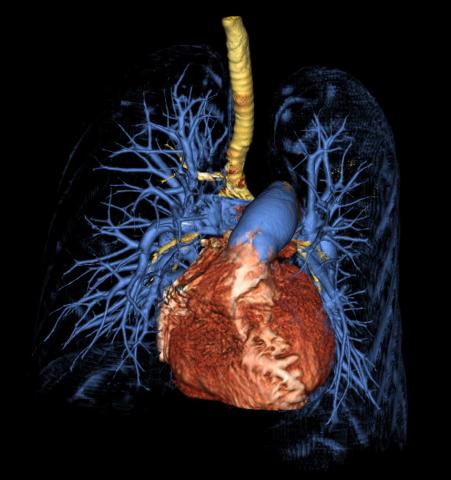Novel Blood Test Evaluates Severity in Rare Lung Disease

Photo: Dr. Marcus Chen / NHLBI
NIH researchers have found that a novel blood test can easily evaluate disease severity in patients with pulmonary arterial hypertension (PAH) and predict survivability. PAH is a rare, life-threatening condition that causes unexplained high blood pressure in the lungs. Results of the study, which was funded by NHLBI and the Clinical Center, will appear online in the journal Circulation, a publication of the American Heart Association.
The new blood test measures DNA fragments shed by damaged cells. Researchers found that these fragments, called cell-free DNA, were elevated in the blood of patients with PAH and increase with disease severity.
If future studies confirm the findings, this first-of-its-kind blood test for PAH patients could allow doctors to intervene faster to prevent or delay progression of the disease and possibly save lives.
Cell-free DNA is a relatively new analytical technique that is growing in its potential medical uses, which include the early detection of heart- and lung-transplant rejection as well as early detection of cancer.
PAH is a rare form of pulmonary hypertension that can cause difficulty breathing, chest pain and fatigue. The disease is estimated to affect less than 50,000 people in the U.S. The cause remains unknown and there currently is no cure.
Patients with PAH have a high death rate; the condition mostly affects women.
Current tests used to monitor PAH severity rely on the use of an invasive catheter to measure pressure in the lungs. Other diagnostic tools to measure PAH tend to lack reliability and sensitivity.
In the current study, the research team analyzed cell-free DNA from blood samples taken from 209 adult patients, predominantly women, diagnosed with PAH at 2 large U.S. medical centers. The researchers compared the results to cell-free DNA measured from a control group of 48 healthy volunteers without PAH at the Clinical Center.
They found that cell-free DNA was elevated in patients with PAH and cell-free DNA concentrations increased in proportion to the severity of the disease. Patients with the highest level of cell-free DNA had a 3.8 times greater risk of either death or a need for lung transplantation compared to those with the lowest level of cell-free DNA.
Further analyses of cell-free DNA samples revealed that multiple tissue types—including the heart, blood vessels, fat tissue and inflammatory cells circulating in the blood—were affected by PAH.
The new blood test will allow researchers to better pinpoint the specific tissues involved in the PAH disease process, which may lead to new drug interventions.
“Here, we’re proposing a one-time test where you collect a vial of blood from a patient and use that to predict survival," said Dr. Sean Agbor-Enoh, study co-author and chief of NHLBI’s Laboratory of Applied Precision Omics. “We’re very encouraged by the early results.”
